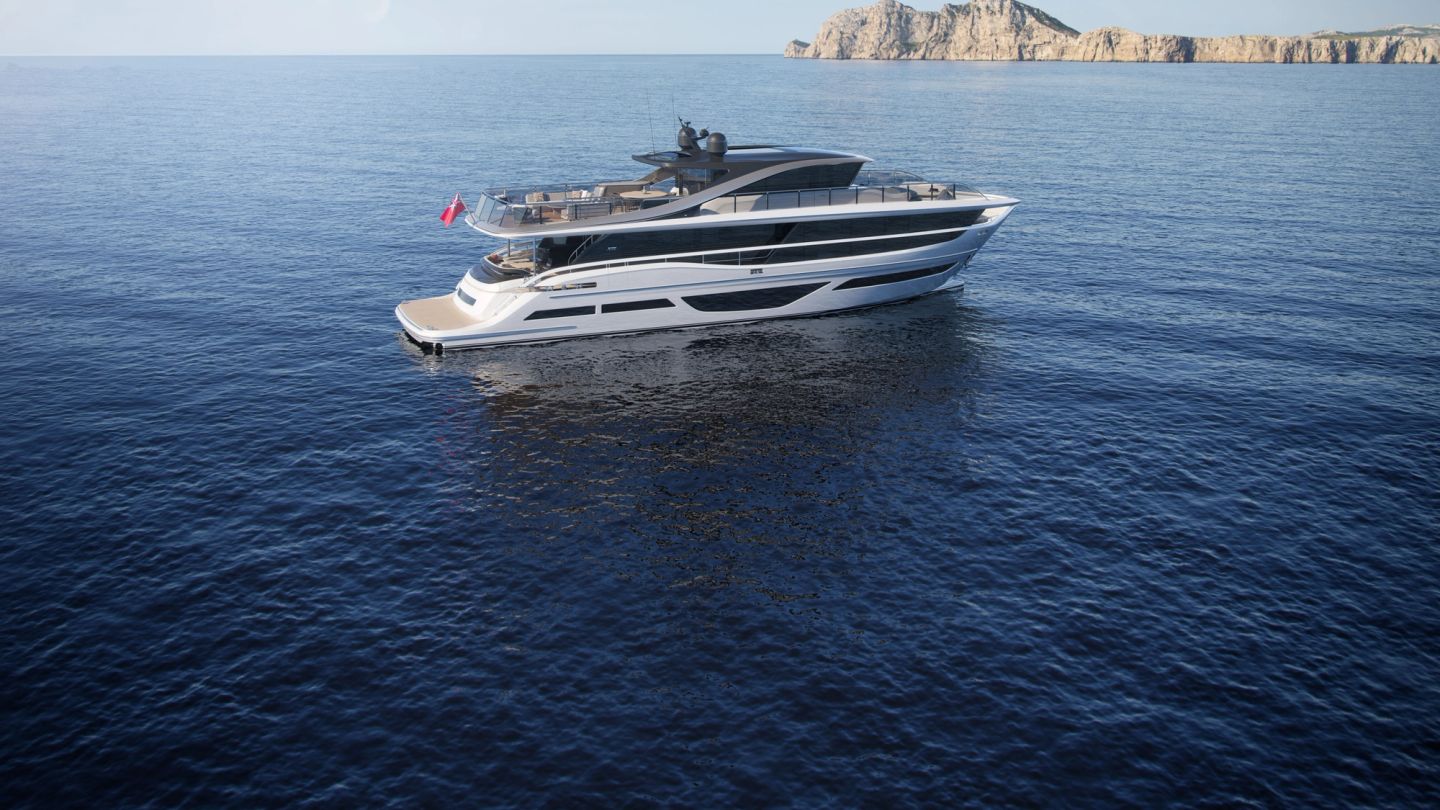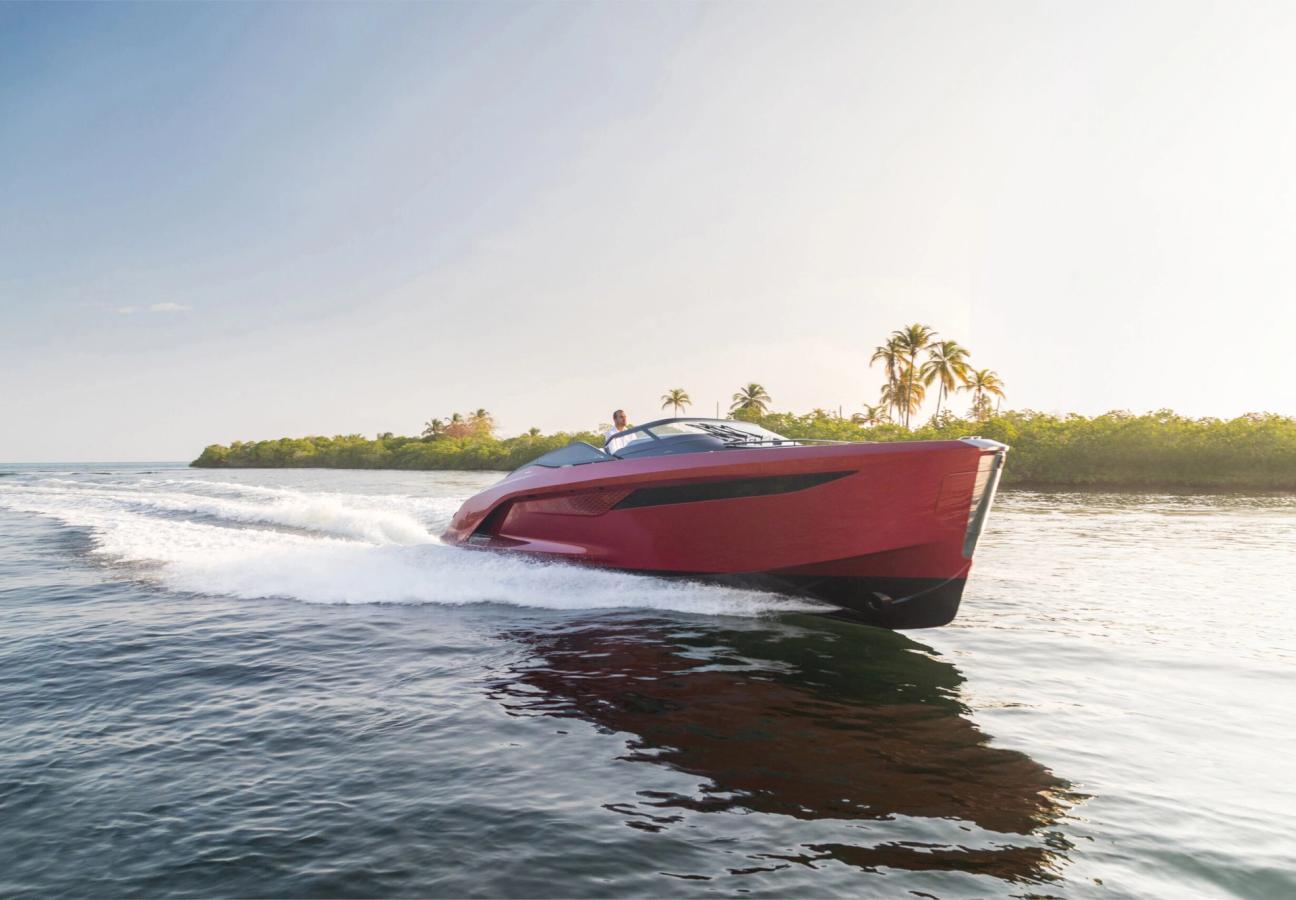

‘We don’t build anything in Britain anymore!’. You’ve likely heard it said. It’s a resounding, complaining cry that seems to echo around our nation; bellowed by a certain type of person with a certain way of thinking. But that person, whoever they may be, has clearly never been to Plymouth.
Because, down on Britain’s wild and windy south coast, the British are not only building — they’re pioneering. Princess Yachts, a royally impressive and undeniably ship-shape boatmaker, is one of the last century’s most buoyant business success stories. So step aboard, and find out how the brand came to be.
Princess Y72, of the ‘Y Class’ range
Princess Y78, of the ‘Y Class’ range
The company began as a passion project among a handful of friends. Founder Dave King left the Royal Navy in 1965 and spent his free time building a modest charter boat — in a small shed by Plymouth’s Stonehouse Creek. Back then, Plymouth remained a nautical powerhouse, employing over 15,000 workers.
The city was riding the crest of a wave — and so to was King. When he was nearing completion on his boat build, a couple of curious passers-by offered to buy it from him. He agreed — but soon discovered that he didn’t charge enough for the vessel. To right this wrong, King and his friends decided to buy several more boats to refurbish, rebuild and resell. And, before they knew it, they had a boatbuilding business.
This company, then-called Marine Projects, created its first ever mass-produced boat — the 31-foot ‘Project 31’ motor cruiser — soon after, and sold it for £3,400. Demand increased dramatically, with almost 150 orders following in the next four years. The brand grew, and began building over 500 sailing yachts a year — as well as powerboats.

Princess V55, of the ‘V Class’ range
But then, in the early 1990s, a recession ravaged the brand’s traditional business model. The waters suddenly turned choppy — and, by 2001, Marine Projects had rebranded as Princess and decided to focus on yachts. But it still wasn’t plain sailing. The 2008 recession threatened to sink the UK-wide boatbuilding industry — and the brutal storms of February 2014 did millions of pounds of damage to boats and equipment in Plymouth.
By 2015, Princess had made a loss of £11 million — a setback, but nowhere as damaging as competitor Sunseeker’s £41 million loss. And, as Kiran Jay Haslam, Chief Marketing Officer at Princess tells us, the brand had to begrudgingly make job cuts.
“We made structural changes and conceded that the market would not just bounce back to where it was in pre-2009,” Haslam tells Gentleman’s Journal. “We had to change, but we tried to do it in a sensible way, going for the least amount of impact possible.”
Princess F62, of the ‘F Class’ range
Princess F55, of the ‘F Class’ range
Princess F62, of the ‘F Class’ range
Princess F50, of the ‘F Class’ range
By 2016, the company was turning a profit once more — and fulfilling every order placed. How did they manage it? Plymouth. The brand has five sites dotted all over the region, totalling an incredible 1.1 million square feet. And everything, every beautiful detail, is crafted and finished in those south coast shipyards. From naval architects to designers and engineers, Princess’ people work fastidiously on-site every day — which enables the brand to consistently monitor quality throughout each build.
“Because we’re so self-sufficient,” explains Haslam, “it means we can turn around new models quicker. The design ethos is that we do it all ourselves and that has the knock-on effect of giving us a strong identity. It’s harder to “turn the tap off” on certain departments than if we were outsourcing – but our logistics are unmatched.’”
“Because we’re so self-sufficient, it means we can turn around new models quicker..."
They certainly are. As of 2021, Princess produces over 20 separate models — split into six classes. The ‘R Class’ is a range of Performance Sports Yachts harnessing new technologies, materials, and engineering. The ‘V Class’ sees six Sports Yachts vie for the titles of sleekest, speediest and most sophisticated.
The three types of ‘S Class’ Sportbridge Yachts bridge the gap between luxurious comfort and dynamic agility. The ‘F Class’ Flybridge Yachts are innovatively and spaciously proportioned — as are the quartet of sumptuous vessels that make up the Motor Yacht ‘Y Class’. And, finally, the ‘X Class’ offers two incredible Super Flybridge Yachts — with the Princess X95 boasting space akin to a megayacht (the much-anticipated X80 will launch this autumn).

Princess R35, of the ‘R Class’ range
Space is a key concept in the creation of a Princess vessel. And the brand’s pioneering deep-V hulls, born from the resident naval architects’ obsession with exceptional seakeeping and voluminous space, create greater internal volume thanks to a lightweight, resin-infused hull composite.
This ingenious design ensures it requires less power and burns less fuel for a Princess Yacht to achieve its maximum design speed. And it is this precision thinking that allows for such exhilarating performance, defined by its efficiency, agility and poise.
Princess’ South Yard site is the shiny face of the company — rumour has it there’s a helipad there, should any particularly well-heeled clients wish to make a flying visit. But it’s the larger 27-acre Coypool site to the north that’s the engine room of each ship. It is there that the components for every boat are produced; from coffee tables to bathrooms; water tanks to wiring looms; hull mouldings to stainless steel accessories. This not only allows Princess to produce boats more quickly than its rivals — but, crucially, allows them to keep a keen eye and attention to detail trained on every step of the production process.
“The first thing I did when I got control of the marketing department was to put “Crafted in Plymouth, England” below the logo,” reveals Haslam. “It’s our stamp of quality. It also indirectly tells customers that we know what we’re doing, we employ locally, and we’ve been doing this since 1965.”
It’s a long-term, foundation-laying approach that has guaranteed the company’s enduring success. The brand’s boats can be found proudly moored in marinas all over the world because they have such an impressive distribution network — 55 dealers worldwide. Each customer spends an average of £1 million per purchase and, last year, the brand made an ‘unprecedented’ £30 million of sales at the Düsseldorf Boat Show alone.
This success — coupled with craftsmanship, and adherence to stringent employability standards including the modern slavery act to the gender pay gap — has resulted in a steadier, happier workforce. The average Princess employee is 41 years old, and the average length of service is 11 years. The company encourages young people from the town to join, training over 100 apprentices each year, undertaking intermediate and advanced apprenticeships and NVQ programmes. They also try to keep them in jobs as long as they can.
Princess S62, of the ‘S Class’ range
Princess S66, of the ‘S Class’ range
Or as Princess’ Haslam puts it candidly: “We try not to lose people, even if that hits profitability. If you lose talent, it’s so hard to bring it back to Plymouth. We’re so accustomed to the talent in the city. It’s easy to say it’s just Plymouth. It’s down near Cornwall, near Devon and that’s it. But, to the outside world, the global marketplace, they say: ‘Plymouth – wow’. Think about all the great stuff the town started, from creating America, to the point where Charles Darwin set sail to discover Galapagos. There’s an incredible history here.”
And it’s a history Princess are keen to preserve. Proud eco-campaigners, the brand is the first luxury yacht manufacturer to officially partner with the Marine Conservation Society. Since 2016, Princess has worked together to support marine environments, preserving reefs and sea life for present and future generations.
The Plymouth-based brand is particularly proud of its custodian status at Eddystone Reef – an offshore ecosystem close to shore. The Marine Conservation Society plays an instrumental role in protecting the reef from damaging fishing practices — and Princess helps to support this vital research.
“There are 50 Plymouths around the world,” continues Haslam. “And the 49 others are based on this one Plymouth, which is where we call home, which we are proud to be part of. There’s a rooting down of who we are as a manufacturing entity into this location. And that’s the ethos that we keep throughout the organisation.”
Want to know more about the Princess X95? Here’s why it’s turning heads…
Become a Gentleman’s Journal member. Find out more here.



